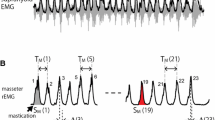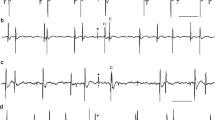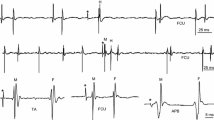Abstract
The aim of the present study was to investigate the existence or otherwise of a functional recurrent inhibitory system (Renshaw cell system) in the motoneurons that innervate human masticatory muscles. In a previous study, l-acetylcarnitine (l-Ac), a substance known to potentiate recurrent inhibition in humans was found to alter, in a specific way, the discharge variability, and the synchronous activity of motor units depending on the presence or absence of recurrent inhibition in the corresponding motoneuron pool. Using a similar paradigm, we have recorded the tonic discharge activity of motor unit pairs from the masseter muscle during voluntary isometric contraction while subjects were undergoing continuous intravenous saline (SAL, NaCl 0.9%) perfusion. Following a brief baseline-recording period, the subjects were given a test injection of either l-Ac or isotonic saline (SAL) in a double blind manner. The variability, synchronization, and coherence between the motor unit discharges were analysed during three successive periods: pre-injection, during injection, and post-injection, each lasting 2–3 min. Neither l-Ac nor SAL injection induced a significant change in the inter-spike interval (ISI) or the coefficient of variation of the ISIs in the motor units tested. There were also no significant changes in the pattern of synchronous activity or in the coherence, which reflects the common frequency content of the unit discharges. Reminiscent of what had been observed previously with motoneurons without recurrent inhibition in the Abductor Digitorum Minimi muscle, the lack of effects of l-Ac injection on the firing behaviour of masseter motoneurons may suggest that classical Renshaw cell inhibition is lacking in this motoneuron pool.







Similar content being viewed by others

References
Adams L, Datta AK, Guz A (1989) Synchronization of motor unit firing during respiratory and postural tasks in human sternocleidomastoid muscle. J Physiol 41:213–231
Alkondon M, lbuquerque EX (2003) The nicotinic acetylcholine receptors subtypes and their function in the hippocampus and cerebral cortex. Prog Brain Res 145:109–120
Aoki S, Uchida S, Inoue H (2005) Fatigue-related changes in discharge patterns of motor units in the inferior head of the lateral pterygoid muscle in humans. Arch Oral Biol 50:727–737
Appenteng K, Donga R, Williams RG (1985) Morphological and electrophysiological determination of the projections of jaw-elevator muscle spindle afferents in rats. J Physiol 369:93–113
Blum K, Seifter E, Seifter J (1971) The pharmacology of d- and l-carnitine and d- and l-acetylcarnitine: comparison with choline and acetylcholine. J Pharmacol Exp Ther 78:331–338
Bolt KJ, Orchardson R (1986) Relationship between mouth-opening force and facial skeletal dimensions in human females. Arch Oral Biol 31:789–793
Cruccu G, Romaniello A (1998) Jaw-opening reflex after CO2 laser stimulation of the perioral region in man. Exp Brain Res 118:564–568
Cruccu G, Berardelli A, Inghilleri M, Manfredi M (1989) Functional organization of the trigeminal motor system in man. A neurophysiological study. Brain 112:1333–1350
Datta AK, Farmer SF, Stephens JA (1991) Central nervous pathways underlying synchronization of human motor unit firing studied during voluntary contraction. J Physiol 432:401–425
Davey NJ, Ellaway PH (1988) Control from the brain stem of synchrony of discharge between gamma motoneurons in the cat. Exp Brain Res 72:249–263
De Luca CJ, LeFever RS, McCue MP, Xenakis AP (1982) Control scheme governing concurrently active human motor units during voluntary contractions. J Physiol 329:129–142
Del Santo F, Gelli F, Schmied A, Vedel JP, Rossi A, Mazzocchio R (2006). Motor unit synchronous firing as revealed by determinism of surface myoelectric signal. J Neurosci Methods 155:116–121
Derfler B, Goldberg LJ (1978) Spike train characteristics of single motor units in the human masseter muscle. Exp Neurol 61:592–608
Ellaway PH (1978) Cumulative sum technique and its application to the analysis of peristimulus time histograms. Electroencephalogr Clin Neurophysiol 45:302–304
Farmer SF, Bremner FD, Halliday DM, Rosenberg JR, Stephens JA (1993) The frequency content of common synaptic inputs to motoneurones studied during voluntary isometric contraction in man. J Physiol 470:127–155
Garland SJ, Enoka RM, Serrano LP, Robinson GA (1994) Behavior of motor units in human biceps brachii during a submaximal fatiguing contraction. J Appl Physiol 76:2411–2419
Garnett R, Stephens JA (1980) The reflex response of single motor units in human first dorsal interosseus muscle following cutaneous afferent stimulation. J Physiol 303:351–364
Haase J, Cleveland S, Ross HG (1975) Problems of postsynaptic autogenous and recurrent inhibition in the mammalian spinal cord. Rev Physiol Biochem Pharmacol 73:73–129
Halliday DM, Conway BA, Farmer SF, Rosenberg JR (1999) Load-independent contribution from motor-unit synchronization to human physiological tremor. J Neurophysiol 82:664–675
Hultborn H, Jankowska E, Lindstrom S (1971) Recurrent inhibition from motor axon collaterals of transmission in the Ia inhibitory pathway to motoneurones. J Physiol 215:591–612
Illert M, Kümmel H (1999) Reflex pathways from large muscle spindle afferents and recurrent axon collaterals to motoneurones of wrist and digit muscles: a comparison in cats, monkeys and humans. Exp Brain Res 128:13–19
Illert M, Kümmel H, Scott JJ (1996) Beta innervation and recurrent inhibition: a hypothesis for manipulatory and postural control. Pflügers Arch 432:R61–R67
Iwata N, Sakai Y, Deguchi T (1971) Effects of physostigmine on the inhibition of trigeminal motoneurones by cutaneous impulses in the cat. Exp Brain Res 13:519–532
Kakuda N, Nagaoka M, Wessberg J (1999) Common modulation of motor unit pairs during slow wrist wrist movement in man. J Physiol 520:929–940
Kamogawa H, Hiraba H, Manabe K, Sakanashi T, Sekiguchi T, Inage T (1998) Morphological analysis of cat masseteric motoneurons after intracellular staining with horseradish peroxidase. Brain Res 785:18–23
Katz R, Mazzocchio R, Pénicaud A, Rossi A (1993) Distribution of recurrent inhibition in the human upper limb. Acta Physiol Scand 149:183–198
Kidokoro Y, Kubota K, Shuto S, Sumino R (1968) Reflex organization of cat masticatory muscles. J Neurophysiol 31:695–708
Kiehn O, Eken J (1997) Prolonged firing time in motor units—evidence for plateau potentials in human motoneurons? J Neurophysiol 78:3061–3068
Kilner JM, Alonso-Alonso M, Fisher R, Lemon RN (2002) Modulation of synchrony between single motor units during precision grip tasks in humans. J Physiol 541:937–948
Kirkwood PA, Sears TA (1991) Cross-correlation analyses of motoneurone inputs in coordinated motor act. In: Kruger J (ed) Springer Verlag series in synergetics: neuronal comparativity. Springer, Berlin Heidelberg New York, pp 225–248
Kubota K, Masegi T (1977) Muscle spindle supply to the human jaw muscle. J Dent Res 56:901–909
Löscher WN, Cresswell AG, Thorstensson A (1996) Excitatory drive to the alpha-motoneuron pool during a fatiguing submaximal contraction in man. J Physiol 491:271–280
Lund JP, Lamarre Y, Lavigne G, Duquet G (1983) Human jaw reflexes. Adv Neurol 39:739–755
Mattei B, Schmied A, Mazzocchio R, Decchi B, Rossi A, Vedel JP (2003) Pharmacologically induced enhancement of recurrent inhibition in humans: effects on motoneurone discharge patterns. J Physiol 548:615–629
Mazzocchio R, Rossi A (1989) Further evidence for Renshaw cell inhibition in man. A combined electrophysiological and pharmacological approach. Neurosci Lett 106:131–136
Mazzocchio R, Rossi A (1997) A method for potentiating Renshaw cell activity in human. Brain Res Brain Res Protoc 2:53–58
McCurdy ML, Hamm TM (1992) Recurrent collaterals of motoneurons projecting to distal muscles in the cat hindlimb. J Neurophysiol 67:1359–1366
Moore JA, Appenteng K (1989) The morphology of the axons and axon collaterals of rat jaw-elevator motoneurones. Brain Res 489:383–386
Nakamura Y (1980) Brainstem neuronal mechanisms controlling the trigeminal motoneuron excitability. In: Desmedt JE (ed) Spinal and supraspinal mechanisms of voluntary motor control and locomotion. Prog Clin Neurophysiol Karger, Basel, 8:181–202
Nordstrom MA, Miles TS (1991) Discharge variability and physiological properties of human masseter motor units. Brain Res 541:50–56
Nordstrom MA, Fuglevand AJ, Enoka RM (1992) Estimating the strength of common input to human motoneurons from the cross-correlogram. J Physiol 453:547–574
Role LW, Berg DK (1996) Nicotinic receptors in the development and modulation of CNS synapses. Neuron 16:1077–1085
Rosenberg JR, Amjad AM, Breeze P, Brillinger DR, Halliday DM (1989) The Fourier approach to the identification of functional coupling between neuronal spike trains. Prog Biophys Mol Biol 53:1–31
Rossi A, Mazzocchio R (1991) Presence of homonymous recurrent inhibition in motoneurones supplying different lower limb muscles in humans. Exp Brain Res 84:367–373
Rossi A, Mazzocchio R (1992) Renshaw recurrent inhibition to motoneurones innervating proximal and distal muscles of the human upper and lower limbs. In: Jami L, Pierrot-Deseilligny E, Zytnicki D (eds) Muscle afferents and spinal control of movement. Pergamon, Oxford pp 313–319
Schmied A, Vedel JP, Pagni S (1994) Human spinal lateralization assessed from motoneurone synchronization: dependence on handedness and motor unit type. J Physiol 480:369–387
Schmied A, Vedel JP, Pouget J, Forget R, Lamarre Y, Paillard J (1995) Changes in motoneurone connectivity assessed from neuronal synchronization analysis. In: Taylor A, Gladden M, Durbaba R (eds) Alpha and gamma motor systems. Plenum, New York pp 469–477
Schmied A, Pouget J, Vedel JP (1999) Electromechanical coupling and synchronous firing of single wrist extensor motor units in sporadic amyotrophic lateral sclerosis. Clin Neurophysiol 110:960–974
Sowman PF, Türker KS (2005) Methods of time and frequency domain examination of physiological tremor in the human jaw. Hum Mov Sci 24:657–666
Sowman PF, Brinkworth RSA, Türker KS (2006) Periodontal anaesthesia reduces common 8 Hz input to masseters during isometric biting. Exp Brain Res 169:326–337
Stephens JA, Taylor A (1972) Fatigue of maintained voluntary muscle contraction in man. J Physiol 220:1–18
Taylor A (1990) Proprioceptive control of jaw movement. In: Taylor A (ed) Neurophysiology of the jaws and teeth. Macmillan, London pp 237–267
Tempesta E, Janiri L, Pirongelli C (1985) Stereospecific effects of acetylcarnitine on the spontaneous activity of brainstem neurones and their responses to acetylcholine and serotonin. Neuropharma 24:43–50
Tokizane T, Shimazu H (1964) Functional differentiation of human skeletal muscle. In: Thomas CC (eds) Corticalization and spinalization of movement. Thomas, Springfield, p 66
Türker KS (2002) Reflex control of human jaw muscles. Crit Rev Oral Biol Med 13:85–104
Türker KS, Powers RK (2001) Determining the sign of ‘common’ synaptic inputs underlying synchronization in motoneurons. J Neurophysiol 86:2807–2822
Türker KS, Powers RK (2002) The effect of motoneurone discharge rate on synchronization. J Physiol 541:245–260
Wessberg J, Vallbo AB (1995) Human muscle spindle afferent activity in relation to visual control in precision finger movements. J Physiol 482:225–233
Windhorst U (1990) Activation of Renshaw cells. Prog Neurobiol 35:135–179
Windhorst U (1996) On the role of recurrent inhibitory feedback in motor control. Prog Neurobiol 49:517–587
Yoshida A, Tsuru K, Mitsuhiro Y, Otani K, Shigenaga Y (1987) Morphology of masticatory motoneurons stained intracellularly with horseradish peroxidase. Brain Res 416:393–401
Acknowledgments
This research was supported by grants from the National Health and Medical Research Council of Australia; and the Italian MIUR and Istituto Riabilitazione Fisiomedica Loretana (CB, Italy).
Author information
Authors and Affiliations
Corresponding author
Additional information
An erratum to this article can be found at http://dx.doi.org/10.1007/s00221-006-0837-4
Rights and permissions
About this article
Cite this article
Türker, K.S., Schmied, A., Rossi, A. et al. Is the human masticatory system devoid of recurrent inhibition?. Exp Brain Res 179, 131–144 (2007). https://doi.org/10.1007/s00221-006-0774-2
Received:
Accepted:
Published:
Issue Date:
DOI: https://doi.org/10.1007/s00221-006-0774-2



